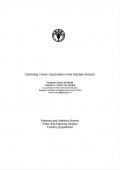This case study advocates for integrating the values of goods and services provided by forest ecosystems into policy making in Tunisia. For example, the study recommends combining forest conservation measures with compensation systems for income losses and creating a Forest Development Fund funded by a tax on products and services provided by forests.
This study describes the Indian forestry-related stocks and flows in terms of land area (under forest), physical volume (of timber and carbon), and monetary values. The study demonstrates that forest resource accounting is feasible in India at a disaggregate level using a top-down approach and provides an interesting view of how different regions are doing when their performance is measured on a sustainability yardstick.
This study conducts a valuation of non-marketed forest resources in Tanzania and proposes means for the generation of modified national accounts that would cover the full value of forest resource production and consumption.
This case study of Guyana aims to demonstrate a method of assessing the use-value of non-timber forest products (NTFPs), using an income accounting framework, in order to demonstrate an extra dimension to forest valuation that is often ignored.
This case study aims to establish the contribution of Ethiopian forests to national income by assessing the value added of the forestry sector, the contribution of forest ecosystems to other sectors, and the annual contribution of forest ecosystems to non-market income. Prior to this study, no full assessment of the income derived from forest-derived goods and services had been undertaken. The only figure available had been the official estimate of the contribution of the forestry industry to GDP (3.8% in 2012-13). By assessing the full contribution of forests to market and non-market income, a more complete picture of their economic importance emerges.
The objective of this case study is to construct forest resource accounts for the state of Maharashtra, India, and incorporate the value of depletion and degradation of forest resources into the system of national accounts (SNA).
This publication summarizes the results and methodological findings of a first round of test applications of the European Framework for Integrated Environmental and Economic Accounting for Forests. Its objective is to provide an insight into the experience gained and progress made in linking forest-related data to the national accounts.
This study demonstrates the economic techniques for estimating the Total Economic Value (TEV) of forests. For the Mexican forest estate, the results show an annual lower bound value of the services of the total forest area to be in the order of $4 billion.

This case study applies forest accounting approaches to estimate economic depreciation of timber exploitation in the Amazonian region.
This report presents the results of an attempt to derive a damage function for soil loss using 20-year data projected through the application of the Erosion Productivity Index Calculator (EPIC) in one soil conservation project site in the Philippines.
